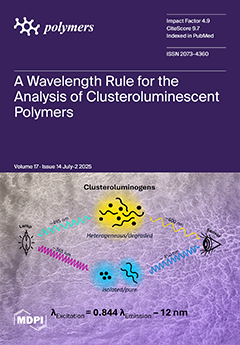Herein, electrospun nanofibers composed of polyaniline (PANI), polyethylene oxide (PEO), and
Luffa cylindrica (LC) cellulose, reinforced with titanium dioxide (TiO
2) nanoparticles, were synthesized via electrospinning to investigate the effect of TiO
2 nanoparticles on PANI/PEO/LC nanocomposites and the effect of conductivity
[...] Read more.
Herein, electrospun nanofibers composed of polyaniline (PANI), polyethylene oxide (PEO), and
Luffa cylindrica (LC) cellulose, reinforced with titanium dioxide (TiO
2) nanoparticles, were synthesized via electrospinning to investigate the effect of TiO
2 nanoparticles on PANI/PEO/LC nanocomposites and the effect of conductivity on nanofiber morphology. Cellulose extracted from luffa was added to the PANI/PEO copolymer solution, and two different ratios of TiO
2 were mixed into the PANI/PEO/LC biocomposite. The morphological, vibrational, and thermal characteristics of biocomposites were systematically investigated using scanning electron microscopy (SEM), Fourier transform infrared spectroscopy (FTIR), X-ray diffraction (XRD), differential scanning calorimetry (DSC), and thermogravimetric analysis (TGA). As anticipated, the presence of TiO
2 enhanced the electrical conductivity of biocomposites, while the addition of Luffa cellulose further improved the conductivity of the cellulose-based nanofibers. FTIR analysis confirmed chemical interactions between Luffa cellulose and PANI/PEO matrix, as evidenced by the broadening of the hydroxyl (OH) absorption band at 3500–3200 cm
−1. Additionally, the emergence of characteristic peaks within the 400–1000 cm
−1 range in the PANI/PEO/LC/TiO
2 spectra signified Ti–O–Ti and Ti–O–C vibrations, confirming the incorporation of TiO
2 into the biocomposite. SEM images of the biocomposites reveal that the thickness of nanofibers decreases by adding Luffa to PANI/PEO nanofibers because of the nanofibers branching. In addition, when blending TiO
2 nanoparticles with the PANI/PEO/LC biocomposite, this increment continued and obtained thinner and smother nanofibers. Furthermore, the incorporation of cellulose slightly improved the crystallinity of the nanofibers, while TiO
2 contributed to the enhanced crystallinity of the biocomposite according to the XRD and DCS results. Similarly, the TGA results supported the DSC results regarding the increasing thermal stability of the biocomposite nanofibers with TiO
2 nanoparticles. These findings demonstrate the potential of PANI/PEO/LC/TiO
2 nanofibers for advanced applications requiring conductive and structurally optimized biomaterials, e.g., for use in humidity or volatile organic compound (VOC) sensors, especially where flexibility and environmental sustainability are required.
Full article






